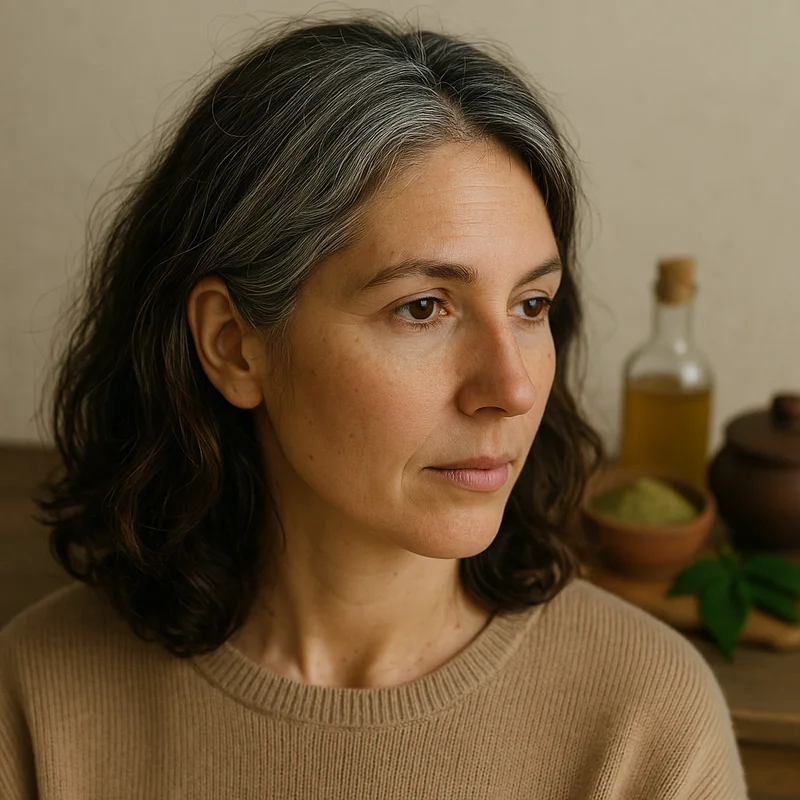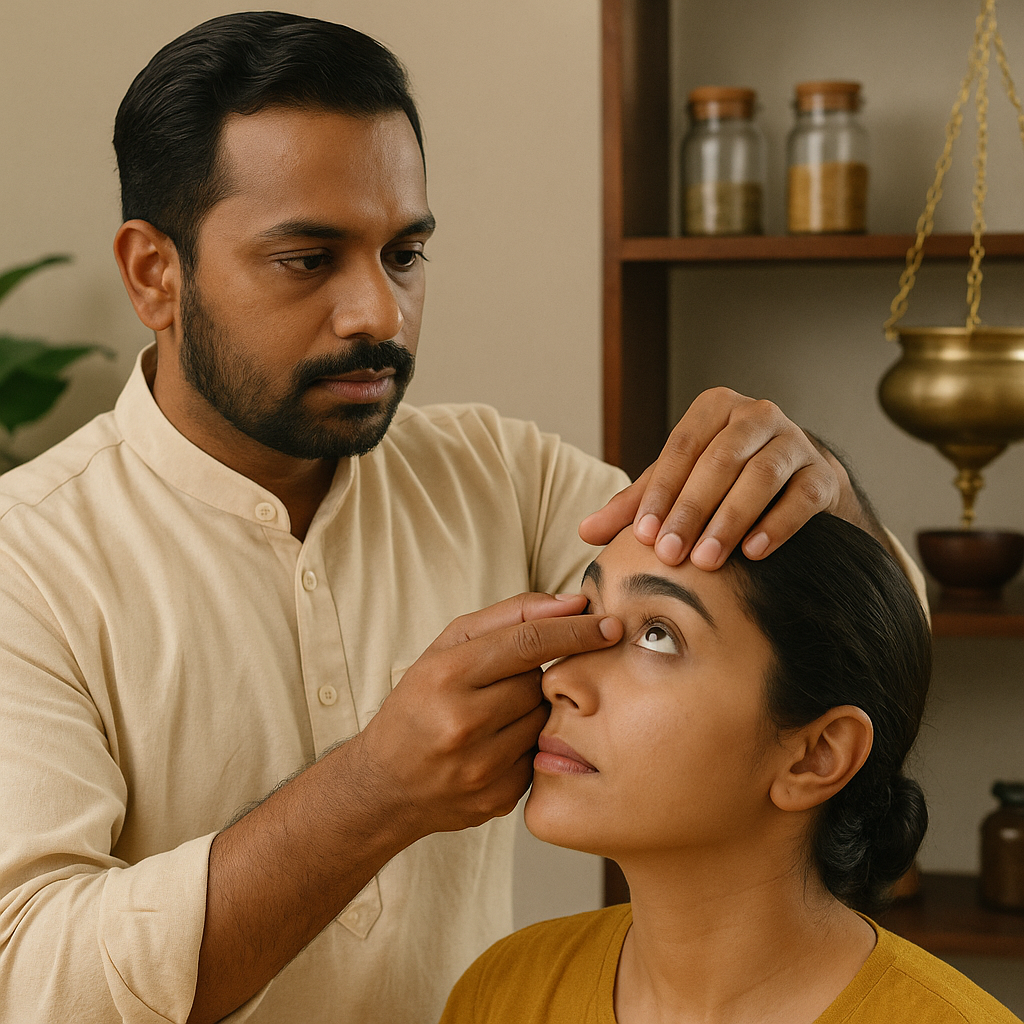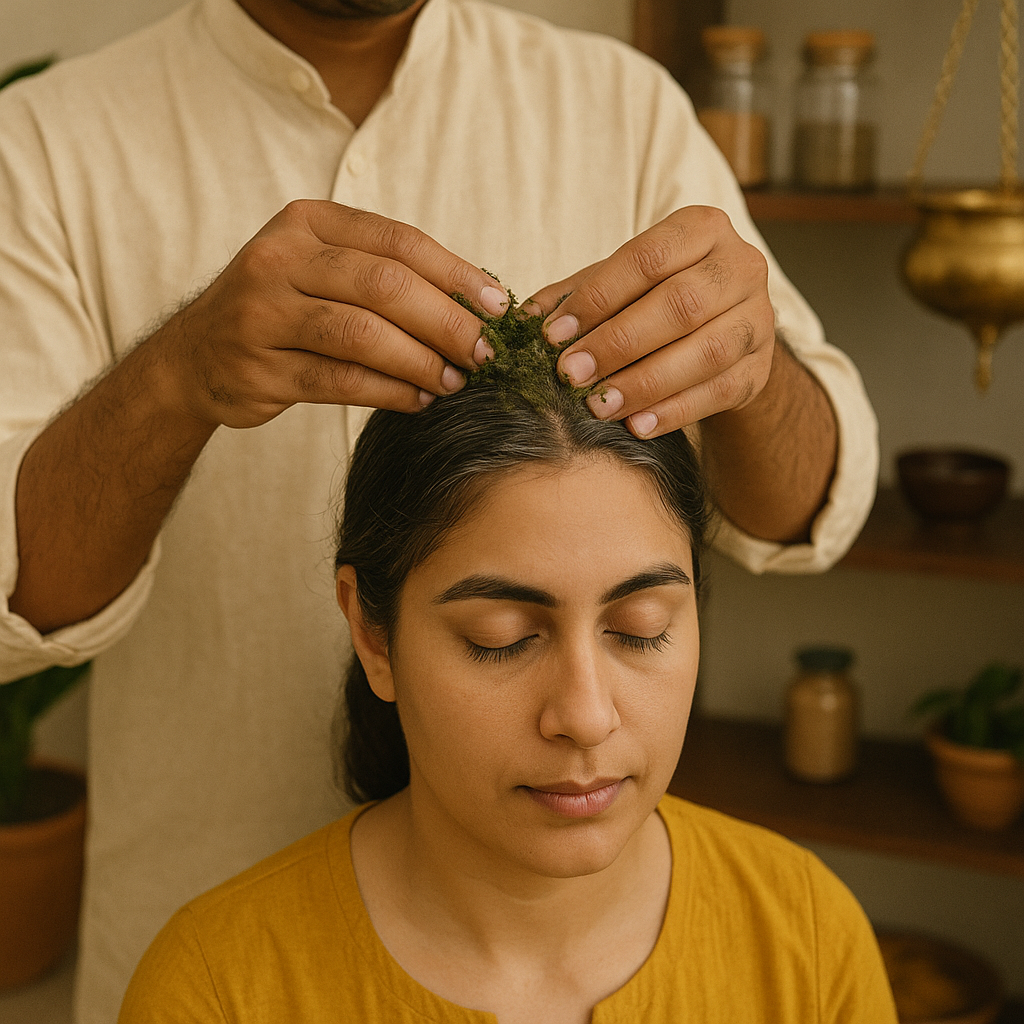Ask Ayurvedic doctor a question and get a consultation online on the problem of your concern in a free or paid mode. More than 2,000 experienced doctors work and wait for your questions on our site and help users to solve their health problems every day.
Shop Now in Our Store
Ayurvedic Medicine for Premature Grey Hair: What You Really Need to Know

Introduction
Let’s talk about something that sneaks up on a lot of us—premature grey hair. And no, this isn’t just a vanity thing or a fleeting cosmetic concern. It’s deeper than that. It’s a visible signal that something inside might be off-balance. In Ayurveda, grey hair isn’t just a pigment problem—it’s a prakriti clue, a whisper from your body that your doshas might be acting up.
Now, maybe you’ve spotted those first silvery threads in your twenties. Or maybe they arrived in your thirties, and now they’ve multiplied like they own the place. Either way, you’re not alone. Studies suggest that premature greying affects nearly 15–30% of the global population under age 30. The numbers are rising, and while genetics play a part, our stress-baked, junk-fueled, sleep-deprived modern lives aren’t helping either.
But here's the twist: Ayurveda offers a radically different lens to view this condition. It doesn’t just slap on a diagnosis. It listens. It connects. It personalizes. Where modern medicine sees melanin depletion, Ayurveda sees the dance of Pitta, the exhaustion of vital essence (Ojas), and the fiery imbalance that can prematurely “burn” out the natural hair color.
This article isn’t just a list of herbs or a quick-fix hair mask. You’ll get the why behind the white strands, understand how ancient Ayurvedic wisdom interprets it, and explore powerful, time-tested remedies—some you can make in your kitchen, others you’ll find at your nearest Ayurvedic pharmacy.
You’ll learn:
-
Why your hair might be greying too soon (from both scientific and Ayurvedic perspectives)
-
How to decode dosha imbalances linked to this
-
The full list of herbs, oils, therapies, and routines that can help
-
What real patients have experienced using Ayurvedic treatments
-
What research says about how effective this really is
So if you’re curious, frustrated, or just plain tired of plucking out greys like you’re on some eternal maintenance duty—read on. Let’s get into the roots. Literally.

Understanding Ayurvedic Medicine for Premature Grey Hair – An Ayurvedic Overview
What exactly is Premature Grey Hair?
Scientifically speaking, hair turns grey when melanocytes—those tiny pigment-producing cells in your hair follicles—stop working properly. Normally, as you age, this happens gradually. But when it starts in your teens or twenties, it’s classified as premature greying. In the medical world, it’s often tied to things like:
-
Genetics
-
Vitamin B12 deficiency
-
Thyroid dysfunction
-
Oxidative stress
-
Autoimmune conditions like vitiligo
But here’s the kicker—most of the time, no “cause” is found. That’s where the Ayurvedic lens becomes incredibly useful. It doesn’t need a lab test to know something’s off.
In Ayurveda, premature grey hair is called “Akala Palitya”, and it’s seen as a deeper sign of pitta aggravation, often compounded by vata. In layman's terms? There’s too much heat, too much dryness, and a lack of nourishing essence (called Rasa dhatu and Ojas). It’s not just about the follicles; it’s about your whole system being out of tune.
The stages of this condition, according to Ayurvedic texts, begin with subtle signs like dryness, scalp irritation, and emotional volatility (yep, mind and body are linked here). Over time, this turns into discoloration, thinning, and greying. Left unchecked, it might not “harm” your body, but it signals deeper imbalances—especially if it appears along with other issues like acidity, insomnia, or hair loss.
Ayurvedic Perspective: The Dosha Imbalance Behind Grey Hair
Ayurveda always starts with doshas—Vata (air & space), Pitta (fire & water), and Kapha (earth & water). Premature greying is primarily a Pitta-vitiated condition, sometimes worsened by Vata’s drying influence.
Let’s break it down:
-
Pitta governs heat and transformation in the body. When it’s too high (due to spicy food, anger, stress, etc.), it “burns out” the melanocytes faster.
-
Vata causes dryness and degeneration. When aggravated, it speeds up aging, dries out the scalp, and reduces nourishment to the hair root.
-
Kapha, usually protective, can sometimes stagnate the system if out of balance, but it’s less implicated in greying directly.
And guess what? Diet, emotions, sleep, and even seasonal shifts can push these doshas out of balance. Ayurvedic texts list causes like:
-
Excessive intake of sour, salty, spicy, and fermented foods
-
Overexertion and sleep deprivation
-
Chronic anger, frustration, or jealousy
-
Overexposure to sun and heat
-
Suppression of natural urges (yes, holding in sneezes or gas matters too!)
How Ayurveda’s View Differs From Modern Medicine
Western dermatology treats premature grey hair like a cosmetic or genetic issue, sometimes recommending B12, antioxidants, or hair dyes.
Ayurveda, in contrast, says:
-
This is a systemic issue. The solution isn’t just topical—it's internal.
-
It’s not a “problem to fix” but a message from your body.
-
The root cause often lies in lifestyle, digestion (Agni), and emotional health—not just in follicles.
Ayurveda doesn’t just look at the hair. It looks at you. Your temperament, your gut, your routines, your mental state—all are part of the diagnosis and the cure.
So while the West might give you a serum or supplement, Ayurveda hands you a lifestyle, a philosophy, and a toolkit. It's not a one-size-fits-all fix. It’s personalized, holistic healing.
Causes and Triggers of Premature Grey Hair (Ayurvedic Insights)
Main Underlying Ayurvedic Causes of Premature Grey Hair
Ayurveda doesn’t believe things “just happen.” If your hair is greying early, something’s out of alignment.
At its core, Akala Palitya (premature greying) is seen as a Pitta-dominant condition. Specifically, the sub-type called Bhrajaka Pitta, which governs skin and hair pigmentation, is said to be overheated or depleted. Once it gets aggravated, it scorches the pigment-producing cells. Not instantly—this is a slow roast over years of lifestyle habits.
Another major factor is the depletion of Rasa Dhatu, the first of the seven bodily tissues. If your digestion (Agni) is weak, and your food doesn’t nourish you at the cellular level, your hair feels it first. Think of it like this: hair is kind of like a luxury item your body produces only when it has extra nourishment to spare.
Also, Ayurveda talks about Dhatukshaya (tissue depletion) and Ojakshaya (loss of vitality or immunity), which can quietly contribute to greying.
And yes, even hereditary factors are acknowledged in Ayurveda—but the emphasis is more on breaking the cycle than blaming it.
Common Triggers and Risk Factors Identified in Ayurveda
You’ll probably recognize some of these in your own life (most of us do):
-
Eating while stressed or angry – This seriously disturbs digestion and vitiates Pitta.
-
Overconsumption of fermented, sour, spicy, and oily foods
-
Staying up late regularly – Ruins the body's natural detox cycle, dries out Vata.
-
Skipping meals or inconsistent meal times
-
Suppressing emotions or natural urges (yep, holding back a sneeze can have consequences in Ayurveda)
-
Frequent exposure to sun or high temperatures
-
Worrying too much or being emotionally “heated” all the time
All these seemingly small things chip away at your internal balance. And eventually, they show up as white hairs that seem to sprout overnight.
Why the Modern Lifestyle is a Greying Machine
Ayurveda was written thousands of years ago, yet it totally predicted modern life. Seriously. If someone back then had described 2025, they’d say: “Too much screen light, processed food, emotional overstimulation, bad sleep, no breath between thoughts.” Sound familiar?
Here’s the real kicker: stress. Not the dramatic kind, but the background buzz—the never-ending inbox, the arguments left unresolved, the future planning, the doom-scrolling. Chronic mental tension aggravates Pitta and Vata, messes up digestion, and leads to—you guessed it—premature greying.
Pair that with crash diets, too much coffee, overexercising, binge-watching until 2 a.m., and you've got a perfect storm.
Recognizing Symptoms & Early Signs of Premature Grey Hair
Typical Symptoms (From Obvious to Subtle)
It usually starts small. A single silvery thread. Then two. Maybe at the temples. Then the crown. Or worse—at the back of your head, where you can't even see it unless someone points it out (helpfully, of course).
Here’s a breakdown of how premature greying can present:
-
Appearance of grey or white hairs before the age of 30 (20 for Caucasians, 25 for Asians, 30 for Africans).
-
Gradual increase in white strands, especially around temples, scalp edges, and beard in men.
-
Dry, brittle hair texture – This isn’t just aesthetic; it points to Rasa Dhatu depletion.
-
Increased hair fall or thinning
-
Scalp dryness or itching
-
Sensitivity to heat, light, or stress – A Pitta sign often seen alongside early greying.
Less Obvious or Overlooked Signs
Ayurveda loves the subtle stuff—the whispers before the screams. Some overlooked signs that might be connected:
-
Digestive issues (bloating, gas, hyperacidity) – Your gut and your hair health are intertwined.
-
Emotional burnout or irritability
-
Poor sleep quality or strange dreams
-
Premature skin aging or dullness
-
Lack of sweating or over-sweating – Both can indicate dosha imbalances
If you’ve got a combo of these and white hair showing up early, it’s time to listen.
When Should You Seek Ayurvedic Help? And When It Might Not Help
Seek help if:
-
You notice greying before 25 and it’s accelerating
-
You have digestive or skin issues along with it
-
There’s a family history, but you want to prevent rapid worsening
-
You’ve tried supplements and serums, but nothing’s helped
When Ayurveda might not help:
-
If the hair is already entirely white (Ayurveda isn’t hair dye)
-
If greying is caused by irreversible genetic or autoimmune factors
-
If the goal is instant reversal—this is a gradual rebalancing, not a 7-day miracle fix
Still, most people can benefit from Ayurveda even if it doesn’t bring color back—it improves hair strength, reduces hair loss, and supports overall wellbeing.

Ayurvedic Diagnosis Methods for Premature Grey Hair
Pulse Diagnosis, Tongue Analysis, and Other Traditional Methods
Ayurvedic doctors (called Vaidyas) use a whole range of diagnostic tools that might feel a bit mystical—but they’re grounded in centuries of observation.
-
Nadi Pariksha (Pulse Diagnosis): By feeling your radial pulse, a skilled Vaidya can assess dosha imbalances, organ function, even emotional states. It’s kind of like listening to your body’s hidden language.
-
Jihva Pariksha (Tongue Analysis): The color, coating, and texture of your tongue give clues about digestion, toxins (Ama), and dosha status.
-
Netra and Sparsha Pariksha (Eye and Skin Examination): Dullness, dryness, or discoloration in these areas can signal internal deficiencies or heat.
-
Detailed Lifestyle Interview: What time do you wake? What do you eat for breakfast? How do you feel at sunset? These might seem like casual questions, but they offer deep insights.
Determining Dosha Imbalance Specific to Premature Grey Hair
Based on your physical traits, mental tendencies, and current symptoms, an Ayurvedic practitioner will determine your Prakriti (your base constitution) and your Vikriti (current imbalance). Most premature grey hair cases fall under:
-
Pitta-Vata imbalance
-
Sometimes Pitta-Kapha if there’s excess oiliness and stagnation
Understanding this helps in choosing the right herbs, therapies, and diet. Two people with the same hair issue might get completely different treatments—and that’s the magic of Ayurveda.
Ayurvedic Treatments & Remedies for Premature Grey Hair
Ayurvedic Herbs and Medicines
Here’s where it gets exciting—Ayurveda’s herbal pharmacy is loaded with goodies that help slow or sometimes even reverse premature greying.
-
Bhringraj (Eclipta alba) – The king of hair herbs. Often used in oils, powders, or capsules.
-
Amla (Indian Gooseberry) – Rich in Vitamin C, rejuvenates Rasa and delays aging.
-
Brahmi – Calms stress, supports mental clarity, and reduces Pitta.
-
Ashwagandha – Adaptogen that helps with stress-induced greying.
-
Shankhpushpi – Nourishes the mind and promotes calmness.
-
Triphala – Detoxifying combo to improve digestion and assimilation.
Recommended Forms:
-
Oils: Bhringraj oil, Amla oil, Neeli oil
-
Capsules: Bhringraj, Amla, or combination hair formulas
-
Churna (powders): For teas or topical masks
-
Lehya (herbal jams): Like Chyawanprash, which strengthens immunity and slows aging
Dosages vary by person, so always consult an Ayurvedic practitioner before regular use.
Ayurvedic Therapies and Panchakarma Treatments
-
Shirodhara: Warm oil poured on the forehead – deeply calming and Pitta-reducing.
-
Nasya Therapy: Herbal oil drops administered through the nose to clear channels and support brain and scalp health.
-
Abhyanga (Oil massage): Calms Vata and nourishes the scalp.
-
Virechana (Purgation): Detox therapy that flushes excess Pitta from the system.
These treatments are often done in clinics under supervision and can have powerful long-term effects when combined with herbs and diet.
Effective Ayurvedic Home Remedies and Self-Care Advice
-
Scalp massage with warm Bhringraj or Amla oil 3x per week
-
Drinking Amla juice or taking Amla powder in warm water daily
-
Applying a hair mask of yogurt, curry leaves paste, and Amla powder once a week
-
Coconut oil infused with curry leaves—simmer fresh leaves in oil, cool, strain, and use regularly
Add breathing exercises like Anulom-Vilom (alternate nostril breathing), which balances Pitta and calms the nervous system.
Diet & Lifestyle Recommendations for Managing Premature Grey Hair
Recommended Foods and Dietary Guidelines
Food is medicine. And in Ayurveda, it's not just what you eat — it's when, how, and with what mindset you eat it.
Here’s what to put on your plate if premature greying is something you’re dealing with:
-
Amla (fresh or powdered): Daily. Mix in warm water or honey.
-
Sesame seeds (black): A small handful a few times a week — excellent for hair pigmentation.
-
Ghee: Just a teaspoon a day can balance Pitta and nourish the tissues.
-
Mung dal (split green gram): Light, digestible protein that strengthens hair roots.
-
Coconut: Fresh or dry, coconut supports cooling and hair growth.
-
Leafy greens: Particularly Brahmi leaves, curry leaves, and spinach (but not raw — always lightly cooked).
-
Warm spiced milk (with turmeric or nutmeg) before bed: Helps with sleep and hair nourishment.
Eat on time. Avoid cold, stale, or processed foods. Prefer fresh, home-cooked meals — ideally warm and seasoned with cumin, coriander, turmeric, and fennel.
Try to eat your largest meal at midday, when digestion is strongest. Keep dinner light and early.
Foods and Drinks to Avoid
You might not want to hear this. But certain beloved foods can seriously mess with your doshas:
-
Fermented foods (pickles, vinegar, soy sauce): aggravate Pitta
-
Red meat, fried food, and excessive salt
-
Canned, frozen, or overly processed items
-
Too much caffeine or alcohol – These dry out Vata and overheat Pitta.
-
Excessive sour fruits (especially citrus in high amounts)
Avoid food combinations like:
-
Milk + fruits
-
Yogurt + meat
-
Fish + dairy
These combinations generate Ama (toxins), which can block the flow of nutrients and accelerate aging.
Daily Routine and Lifestyle Tips to Control Greying
Routine is underrated. Ayurveda insists on Dinacharya — a structured daily flow that aligns with natural rhythms.
Here’s a sample plan:
-
Wake up before sunrise – Vata time of day; promotes clarity and lightness.
-
Scrape tongue, drink warm water, do light oil pulling
-
Apply oil to scalp a few times a week before your shower
-
Eat breakfast by 8 a.m., lunch by 12–1 p.m., dinner before 7 p.m.
-
Avoid afternoon naps, especially after heavy meals.
-
Exercise moderately — yoga, walking, gentle breathwork
-
Go to bed by 10 p.m. – Late nights aggravate Vata and Pitta
Stick to these routines consistently. You’ll be surprised how much it influences not just your hair, but your energy and mood too.
Real Patient Experiences & Success Stories
I remember this client — let’s call her Nisha. Late twenties, full-time digital marketer, working 12-hour days. She came in with patchy greying at the crown, chronic acidity, and poor sleep. Classic Pitta-Vata case.
We didn’t do anything fancy — just a tailored mix of Triphala, Brahmi oil scalp massage, and a few strict dietary changes. Within three months, she said the greying had visibly slowed. By six months, she saw some darker hair regrowth and better digestion. The transformation was slow, but steady.
Or Ravi, a 35-year-old teacher who’d been dyeing his beard since he was 25. With Panchakarma and herbal support, not only did his hair quality improve, but his stress levels dropped dramatically.
These aren’t miracle stories. They’re just real people who gave their bodies time, attention, and a little help from Ayurveda.

Scientific Evidence & Research on Ayurvedic Effectiveness for Premature Grey Hair
Summary of Findings
While formal large-scale studies on Ayurveda and premature greying are still limited, several herbs used traditionally do have scientific backing:
-
Bhringraj (Eclipta alba): Shown to stimulate hair follicle activity in lab studies.
-
Amla (Emblica officinalis): Rich in antioxidants and promotes melanogenesis (pigment production).
-
Ashwagandha: Known to modulate cortisol and reduce stress-related greying factors.
-
Triphala: Proven digestive and detox benefits, which indirectly support better hair health.
Common Misconceptions About Premature Grey Hair and Ayurveda
Let’s bust a few myths:
-
“Grey hair means you're old.” Not always. In Ayurveda, it's more about internal imbalance than age.
-
“If your parents had it, you’re doomed.” Heredity plays a role, but epigenetics and lifestyle matter too.
-
“Ayurveda is just home remedies.” Nope — it’s a full-fledged medical system with its own logic, diagnostics, and therapies.
-
“You can reverse grey hair instantly.” Sorry, no such thing. Ayurveda works slowly and systemically.
-
“Only external treatments matter.” Actually, internal digestion and mental health are more important in Ayurveda.
Conclusion
Premature grey hair isn’t just about hair. It’s your body telling you something deeper is off. And Ayurveda — with its 5,000+ years of wisdom — listens.
From balancing your doshas, detoxing your system, massaging oils into your scalp, to eating food that genuinely nourishes you — the Ayurvedic approach is all about restoring harmony. Not just hiding the grey.
And here’s what’s beautiful: even if you can’t reverse the greys, you gain stronger, healthier hair. Better digestion. More calm. A life that feels a bit more in rhythm.
If you’re ready to take the next step, don’t guess. Seek personalized advice from an Ayurvedic practitioner who understands your unique constitution.
Or — if you’d like to begin now — get started with an expert at Ask-Ayurveda.com. Your hair (and your whole self) will thank you for it.
Frequently Asked Questions (FAQ)
1. Can Ayurveda really reverse grey hair?
In early stages, yes — especially when it’s caused by stress, poor digestion, or dosha imbalance. With the right herbs and lifestyle changes, color may return. But results vary.
2. How long do Ayurvedic treatments take to show results?
Expect at least 2–3 months of consistent effort to notice changes. Ayurveda is slow, but steady — think of it as healing from the inside out.
3. Is Bhringraj oil safe for everyone?
Generally yes, but do a patch test first. Avoid if you have known allergies to herbs. Pregnant or breastfeeding women should consult a practitioner.
4. Do I have to give up spicy food completely?
Not entirely. Moderation is key. And you can balance spicy food with cooling herbs or ghee to reduce Pitta aggravation.
5. Can stress alone cause grey hair?
Yes. Chronic stress disturbs hormonal and doshic balance. It’s one of the biggest modern contributors to early greying.
References & Authoritative Sources
-
Ministry of AYUSH (India) -
National Center for Complementary and Integrative Health (USA) -
The Ayurvedic Institute -
All India Institute of Ayurveda -
World Health Organization – Traditional Medicine
This article is checked by the current qualified Dr Sujal Patil and can be considered a reliable source of information for users of the site.

